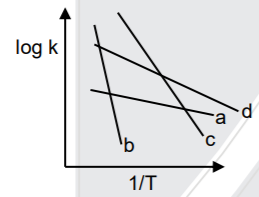In a fission process, nucleus A divides into two nuclei B and C, their binding energies being Ea,Eb and Ec respectively. Then.
Eb+Ec>Ea
Eb+Ec<Ea
Eb+Ec=Ea
Eb−Ec=Ea
The correct Answer is:A
To solve the problem regarding the fission process where nucleus A divides into two nuclei B and C, we need to analyze the binding energies involved. Here’s the step-by-step solution:
Step 1: Understand Binding Energy
The binding energy of a nucleus is the energy required to disassemble it into its constituent nucleons. A higher binding energy per nucleon indicates a more stable nucleus.
Step 2: Analyze the Fission Process
In a fission reaction, a heavy nucleus (A) splits into two lighter nuclei (B and C). This process typically releases a significant amount of energy because the binding energy per nucleon of the products (B and C) is greater than that of the original nucleus (A).
Step 3: Write the Energy Relationship
The energy released (Q value) in the fission process can be expressed as:
Q=(EA−(EB+EC))
Where:
- EA is the binding energy of nucleus A.
- EB is the binding energy of nucleus B.
- EC is the binding energy of nucleus C.
Step 4: Determine the Sign of Q
Since energy is released in the fission process, the Q value is positive. This implies:
EA<EB+EC
This means that the binding energy of the original nucleus A is less than the total binding energy of the two resulting nuclei B and C.
Step 5: Conclusion
From the above analysis, we conclude that:
EA<EB+EC
This indicates that the binding energy of the original nucleus A is less than the sum of the binding energies of the two fission products B and C.
Final Answer
Thus, the correct relationship is:
EA<EB+EC
---
The binding energy of a nucleus is the energy required to disassemble it into its constituent nucleons. A higher binding energy per nucleon indicates a more stable nucleus.
In a fission reaction, a heavy nucleus (A) splits into two lighter nuclei (B and C). This process typically releases a significant amount of energy because the binding energy per nucleon of the products (B and C) is greater than that of the original nucleus (A).
The energy released (Q value) in the fission process can be expressed as:
Q=(EA−(EB+EC))
Where:
- EA is the binding energy of nucleus A.
- EB is the binding energy of nucleus B.
- EC is the binding energy of nucleus C.
Since energy is released in the fission process, the Q value is positive. This implies:
EA<EB+EC
This means that the binding energy of the original nucleus A is less than the total binding energy of the two resulting nuclei B and C.
From the above analysis, we conclude that:
EA<EB+EC
This indicates that the binding energy of the original nucleus A is less than the sum of the binding energies of the two fission products B and C.
Thus, the correct relationship is:
EA<EB+EC
Topper's Solved these Questions
- NUCLEIBOOK - AAKASH INSTITUTE ENGLISHCHAPTER - NUCLEIEXERCISE - ASSIGNMENT (SECTION-A)
40 Videos
- NUCLEIBOOK - AAKASH INSTITUTE ENGLISHCHAPTER - NUCLEIEXERCISE - ASSIGNMENT (SECTION-B)
27 Videos
- NUCLEIBOOK - AAKASH INSTITUTE ENGLISHCHAPTER - NUCLEIEXERCISE - Assignment Section J (Aakash Challengers Questions)
3 Videos
- MOVING CHARGES AND MAGNETISMBOOK - AAKASH INSTITUTE ENGLISHCHAPTER - MOVING CHARGES AND MAGNETISMEXERCISE - Assignment Section J (Aakash Challengers Questions)
5 Videos
- OSCILLATIONSBOOK - AAKASH INSTITUTE ENGLISHCHAPTER - OSCILLATIONSEXERCISE - Assignment (Section D) (ASSERTION-REASON TYPE QUESTIONS)
13 Videos
Similar Questions
When two nuclei (with A=8) join to form a heavier nucleus , the binding energy (B.E) per nucleon of the heavier nuclei is
View SolutionA nuclear of mass M+δm is at rest and decay into two daughter nuclei of equal mass M2 each speed is c
The binding energy per nucleon for the nucleus is E1 and that for the daugther nuclei is E2 Then
View Solution
Knowledge Check
In a nuclear fusion reaction, two nuclei, A & B , fuse to produce a nucleus C , releasing an amount of energy ΔE in the process.If the mass defects of the three nuclei are ΔMA,ΔMB & ΔMC respectively , then which of the following relations holds ? Here, c is the speed of light.
AΔMA+ΔMB=ΔMC−ΔE/c2BΔMA+ΔMB=ΔMC+ΔE/c2CΔMA−ΔMB=ΔMC−ΔE/c2DΔMA−ΔMB=ΔMC+ΔE/c2
This binding energy per nucleon for the parent nucleus is E1 and that for the daughter nuclei is E2. Then
View SolutionCompare Ea (activation energy) for a, b, c and d.

View SolutionO is any point inside a triangle ABC . The bisector of ∠AOB,∠BOC and ∠COA meet the sides AB,BC and CA in point D,EandF respectively. Show that AD⋅BE⋅CF=DB⋅EC⋅FA
View Solutionwhen two nuclei (A≤10) fuse together to form a heavier nucleus, the (a) binding energy per nucleon increases (b) binding energy per nucleon decreases (c) binding energy per nucleon does not change (d) total binding energy decreases
View SolutionThe binding energies of the nuclei A and B are EαandEα respectively. Three atoms of the element B fuse to give one atom of element A and an energy Q is released. Then, Ea,Eb Q are relaetd as
View SolutionIn Figure, ABCD is a parallelogram. E and F are the mid-points of the sides AB and CD respectively. Prove that the line segments AF and CE triset (divide into three equal parts) the diagonal BD.
View SolutionIntracellular space is divided into two distinct compartments, i.e., luminal and extraluminal in :
(a) Nucleus
(b) Endoplasmic reticulum
(c) Golgi bodies
(d) Lysosomes
View Solution
